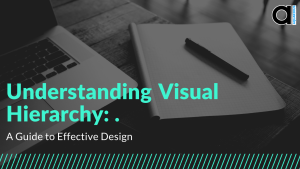Understanding Visual Hierarchy: A Guide to Effective Design

In the fast-paced digital world, capturing and retaining a viewer’s attention is more challenging than ever before. Understanding visual hierarchy is a crucial aspect of the best web site design that can make all the difference. Let’s delve into the nuances of this fundamental concept.
The Significance of Visual Hierarchy
The Power of First Impressions
The power of first impressions is profound, shaping initial perceptions and setting the tone for all that follows. In those crucial moments, impressions are formed swiftly, based on visual cues, body language, and tone. It’s an instinctive process, deeply ingrained in human nature. Whether meeting a person or encountering a design, the first glance holds immense influence. It’s a chance to captivate, to convey credibility, and to establish trust. Understanding this power allows us to craft presentations, designs, and interactions that leave a lasting, positive mark. In essence, the first impression is the gateway to meaningful connections and impactful experiences.
Guiding the Viewer’s Eye
Guiding the viewer’s eye is a fundamental principle in design, particularly in creating visual hierarchy. It involves strategically arranging elements to direct attention towards key focal points. This ensures that the most important information is noticed first, enhancing the overall user experience. Through techniques like size variation, contrast, and placement, designers create a visual path that leads the viewer through the content in a logical and engaging manner. This not only improves comprehension but also conveys a clear message or story. Ultimately, mastering this skill is essential for creating impactful and visually appealing designs that leave a lasting impression.
Elements of Visual Hierarchy
Size and Scale
Size and scale are pivotal elements in the best web site design, dictating prominence and guiding the viewer’s attention. Larger elements naturally draw focus, conveying significance. By strategically sizing and scaling, designers establish a hierarchy within a composition. This deliberate manipulation of proportions directs the viewer’s gaze, ensuring that key elements are noticed first. It creates a visual flow, leading the eye through a design in a purposeful manner. This technique is particularly crucial in web design, where it helps in prioritising content and ensuring a seamless user experience. Ultimately, mastering size and scale is a fundamental skill for any proficient designer.
Contrast and Color
In the best web site design, ‘Contrast and Color’ form a dynamic duo, orchestrating visual impact. The strategic interplay of hues and their relative differences in brightness and saturation draw the eye’s attention. Bold, high-contrast elements command focus, while subtle variations create depth and nuance. Clever use of colour can evoke emotions, convey messaging, and establish hierarchy. Vibrant shades can inject energy, while muted tones offer sophistication. It’s a delicate dance, where the right balance ensures harmony and legibility. Remember, the choice of colours speaks volumes to the viewer, influencing their perception and experience. Mastering this art elevates designs from ordinary to extraordinary.
Typography
Typography is the art of arranging type to make written language legible, readable, and visually appealing. It encompasses font selection, size, spacing, and layout to convey a message effectively. Typography plays a vital role in design, influencing how readers perceive and engage with content. Choosing the right typeface sets the tone for communication, whether formal, playful, or authoritative. Additionally, proper kerning and leading enhance readability, ensuring a seamless flow of text. Understanding the nuances of typography is essential for creating visually compelling materials, from websites to printed materials, contributing significantly to overall design aesthetics.
Alignment and Proximity
In the realm of design, ‘Alignment and Proximity’ are pivotal principles. Proper alignment ensures elements are visually connected and organized, creating a sense of order and clarity. It guides the viewer’s eye, allowing them to effortlessly navigate the content. On the other hand, proximity dictates the spatial relationships between elements. When items are closely grouped, it signifies their relationship, while those spaced farther apart are perceived as distinct. This principle helps establish a visual hierarchy, aiding in the comprehension of content. By mastering alignment and proximity, designers wield powerful tools to enhance the overall visual appeal and effectiveness of their creations.
Implementing Visual Hierarchy in Web Design
Navigation Menus
Navigation menus serve as the digital compass of a website, guiding users through its content. They are a fundamental element of user-friendly web design. By strategically organising and prioritising menu items, designers ensure a seamless and intuitive browsing experience. Dropdown menus, for instance, allow for deeper navigation levels, enhancing accessibility to specific sections. Well-crafted navigation menus also play a crucial role in establishing visual hierarchy, directing attention towards key sections. Clear, concise labels and logical grouping further contribute to user satisfaction. In essence, a thoughtfully designed navigation menu is pivotal in creating a website that is both easy to navigate and engaging for visitors.
Call-to-Action Buttons
Call-to-action buttons, pivotal in the best web site design, prompt user interaction. Strategically placed and employing contrasting colours, they serve as focal points, guiding users towards desired actions. These buttons are succinct, compelling, and clear in their messaging, leaving no room for ambiguity. Their design is carefully considered, ensuring they stand out amidst surrounding elements. They play a critical role in converting visitors into active participants, whether it be for making a purchase, subscribing, or exploring further content. The effectiveness of call-to-action buttons lies in their ability to seamlessly integrate into the visual hierarchy, encouraging a smooth and intuitive user experience.
Headings and Subheadings
Headings and subheadings are crucial elements in structuring written content. They serve as signposts, guiding the reader through the text. In English writing, headings are typically bold or in a larger font, indicating major sections or topics. Subheadings, on the other hand, provide further detail under each heading, breaking down the content into digestible portions. They enhance readability, allowing readers to quickly grasp the main points. Additionally, headings and subheadings contribute to SEO efforts by providing a clear hierarchy of information. This helps search engines understand the content’s relevance and improves the overall user experience.
Images and Graphics
Images and graphics play a pivotal role in shaping visual hierarchy. When strategically placed and appropriately sized, they reinforce the overall design structure. Bold visuals can draw the viewer’s eye, guiding them through the content. Additionally, images serve as powerful tools for conveying information, emotions, and brand identity. High-quality graphics enhance user engagement and make a lasting impression. It’s imperative to ensure that images are optimized for web use to maintain fast loading times. By integrating compelling visuals, designers can create a more immersive and impactful user experience.
In conclusion, understanding and implementing visual hierarchy is paramount for creating designs that resonate with viewers. By mastering elements such as size, contrast, typography, and alignment, designers can craft experiences that captivate and engage.
-
14
+Category
-
98
+Post
Top Categories
Popular Posts
- The Power of Prototyping in Software Development
- Version Control Best Practices for App Development
- Understanding Visual Hierarchy: A Guide to Effective Design
- Crafting Intuitive Navigation: A Guide to Seamless User Experience
- Choose Your Best Cloud Provider
- Making the Leap: Transitioning from Manual to Automated Software Testing
- Using GitHub- Advantages and Disadvantages
- E-commerce Product Photography on a Budget
- Tech Innovation in Developing Countries
- Smart Cities: How Technology is Shaping the Urban Landscape
- Principles of Composition: Creating Visual Harmony with Composition
- Exploring Cross-Platform App Development
- Why Regular Website Updates Matter
- Navigating Effective Facebook Audience Targeting
- Implementing Ads for Game Monetization
- Designing User-Centric Mental Health Apps: Enhancing Well-being in the Digital Age
- NFTs and Collectibles: Creating NFT App Solutions for Collectors and Enthusiasts
- Successful Implementation of Enterprise Apps
- Maximizing Business Impact with EQ
- Proven SMO Ads Optimization Tips (2023)






